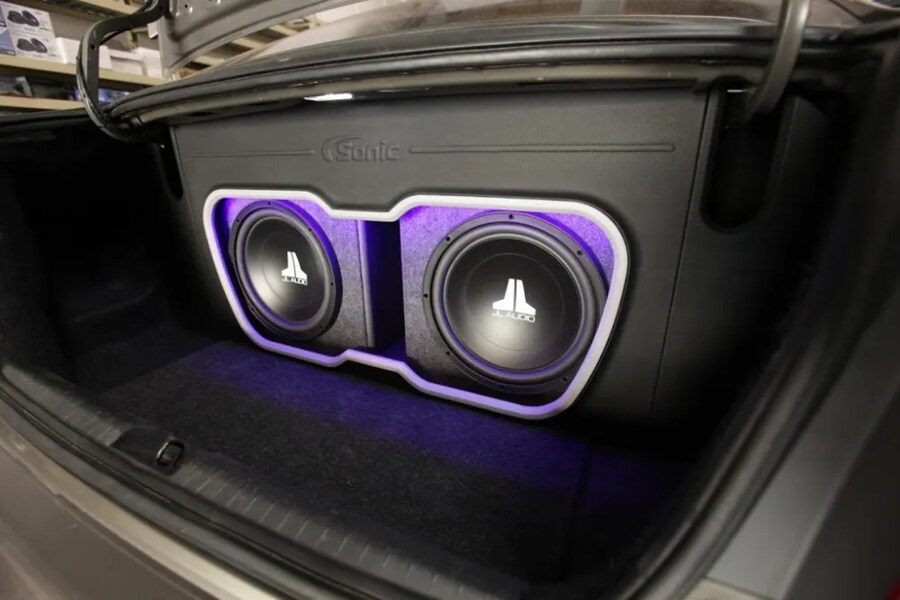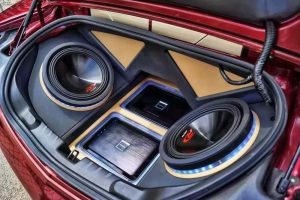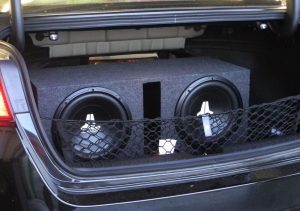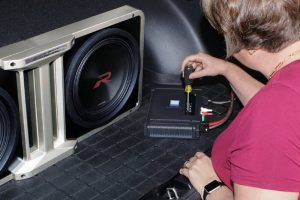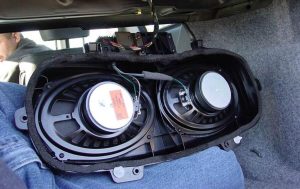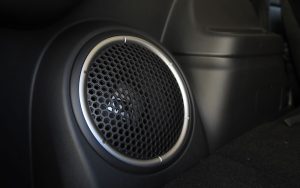Car audio enthusiasts crave deep, rich bass that transforms every drive into a concert-like experience. A subwoofer delivers those low-frequency sounds, but its placement and orientation in your vehicle significantly impact performance. Specifically, deciding which way to face a subwoofer in the trunk sparks endless debates among audiophiles. Should it face the rear, forward, upward, or even downward? The answer depends on your car, preferences, and audio goals. This comprehensive guide explores the best subwoofer orientations, practical tips, and expert insights to help you maximize bass output and sound quality.
Contents
Why Subwoofer Placement Matters
Before diving into specific orientations, let’s understand why subwoofer placement is critical. Subwoofers produce low-frequency sound waves, which behave differently than mid or high frequencies. These waves are omnidirectional, meaning they spread in all directions, but their interaction with your car’s interior affects how you perceive bass. The trunk, a common spot for subwoofers, offers ample space but poses challenges like sound wave reflection, cancellation, and cabin integration.
Proper placement enhances bass response, minimizes distortion, and ensures the sound reaches passengers clearly. Poor positioning, on the other hand, can muffle bass, create rattles, or make the audio feel disconnected from the rest of your system. Factors like trunk size, car type (sedan, SUV, hatchback), enclosure design, and personal taste all influence the ideal setup. Experimenting with subwoofer direction often reveals the sweet spot for your vehicle.
Top Subwoofer Orientations in the Trunk
Let’s explore the most effective ways to face your subwoofer in the trunk, along with their benefits, drawbacks, and ideal use cases. Each orientation offers unique advantages, so consider your car’s layout and listening preferences when choosing.
1. Facing the Rear (Toward the Trunk Opening)
Facing the subwoofer toward the rear of the trunk is the most popular setup among car audio fans. In this configuration, the subwoofer’s cone points toward the back of the vehicle, allowing sound waves to reflect off the trunk’s rear wall or hatch before traveling into the cabin.
Benefits:
- Enhanced Bass Projection: Rear-facing setups maximize bass by using the trunk’s rear surface as a reflective barrier. The sound waves bounce back, creating a fuller, more pronounced low-end experience.
- Even Sound Distribution: This orientation disperses bass evenly across the car, making it ideal for passengers in both front and rear seats.
- Great for Bass-Heavy Genres: If you love hip-hop, EDM, or rap, rear-facing subwoofers deliver the hard-hitting bass these genres demand.
- Reduced Cabin Rattles: By directing sound away from the cabin initially, this setup minimizes vibrations in seats or panels, reducing unwanted noise.
Drawbacks:
- Trunk Space Loss: Positioning the subwoofer close to the rear may limit cargo space, especially in smaller trunks.
- Potential Muffling: If the trunk is heavily soundproofed or sealed, some bass may get trapped, requiring modifications like rear deck ports.
- Car Shows vs. Daily Driving: Rear-facing setups shine with the trunk open (common at car audio events), but daily driving may need adjustments for optimal cabin sound.
Best For:
- Sedans and coupes with sealed trunks.
- Listeners prioritizing powerful, booming bass.
- Vehicles with fold-down rear seats or rear deck openings to let sound into the cabin.
Pro Tip:
Place the subwoofer box about 6–12 inches from the trunk’s rear wall for optimal reflection. Experiment with corner loading (placing the box near the taillights) to boost bass output through constructive interference. For sedans, consider removing rear deck speakers to create ports, allowing bass to flow into the cabin without lowering seats.
2. Facing Forward (Toward the Cabin)
In a forward-facing setup, the subwoofer points toward the rear seats or driver, aiming sound directly into the cabin. This orientation is less common but effective in specific scenarios, especially with custom enclosures or rear seat deletes.
Benefits:
- Direct Bass Delivery: Forward-facing subwoofers send sound straight into the cabin, creating a more immediate and impactful bass experience.
- Ideal for Rear Seat Deletes: If you’ve removed rear seats, this setup maximizes bass transfer to the front, perfect for driver-focused audio systems.
- Custom Enclosure Friendly: Sealed or ported boxes designed to fire forward can integrate seamlessly with the car’s interior, reducing trunk rattle.
- Smooth Music Genres: This setup suits jazz, classical, or acoustic music, where tight, controlled bass enhances clarity over raw power.
Drawbacks:
- Rear Seat Obstruction: In vehicles with fixed rear seats, foam or fabric can muffle bass, reducing output unless you create openings (e.g., ski pass or spacers).
- Less Booming Bass: Forward-facing setups may lack the deep, resonant bass of rear-facing configurations, disappointing fans of heavy low-end.
- Installation Complexity: Sealing the trunk from the cabin or building a custom enclosure requires extra effort and expertise.
Best For:
- Vehicles with rear seat deletes or open cabin designs (e.g., hatchbacks).
- Listeners who prefer precise, controlled bass over overwhelming thump.
- Cars with ski-pass openings or custom audio builds.
Pro Tip:
Position the subwoofer box flush against the rear seats to minimize air gaps. If possible, seal the trunk from the cabin to prevent wave cancellation, ensuring all bass flows forward. For hatchbacks, forward-facing setups work well when paired with a ported enclosure firing through the rear deck.
3. Facing Upward (Toward the Trunk Hatch)
Upward-facing subwoofers point toward the trunk’s roof or hatch, allowing sound waves to disperse throughout the trunk before entering the cabin. This setup is popular for its space-saving design and balanced sound.
Benefits:
- Space Efficiency: Upward-facing subwoofers save trunk space, making them ideal for daily drivers who need room for groceries or gear.
- Balanced Bass Dispersion: Sound waves spread evenly, filling the cabin with consistent bass that’s neither too boomy nor too subtle.
- Reduced Rattles: By directing sound upward, this setup minimizes vibrations in the trunk floor or rear seats, creating a cleaner listening experience.
- Versatile for Music Types: Upward-facing subwoofers handle various genres, from rock to reggae, with smooth, well-rounded bass.
Drawbacks:
- Potential Reverberation: Upward-facing setups may cause excessive reverberation in some trunks, leading to boomy or muddy bass.
- Securing Challenges: The subwoofer must be firmly secured to prevent movement, especially during sharp turns or braking.
- Less Impactful Bass: Compared to rear-facing setups, upward-facing subwoofers may lack the visceral punch some audiophiles crave.
Best For:
- SUVs, hatchbacks, or cars with limited trunk space.
- Listeners seeking balanced bass for mixed music preferences.
- Vehicles with fold-down seats or open trunk-to-cabin pathways.
Pro Tip:
Secure the subwoofer box tightly to avoid movement, and consider adding sound-damping materials to the trunk lid to reduce reverberation. For hatchbacks, pair this setup with a sealed enclosure to maintain tight bass response.
4. Facing Downward (Toward the Trunk Floor)
Downward-facing subwoofers, also called down-firing setups, position the cone toward the trunk floor, often elevated slightly to allow cone excursion. This less common orientation offers unique advantages for specific vehicles and preferences.
Benefits:
- Invisible Bass: Down-firing subwoofers transmit bass through the car’s structure, creating a seamless, “hidden” bass effect that feels immersive.
- Rattle Reduction: By directing sound into the floor, this setup minimizes vibrations in the trunk lid or rear seats, ideal for sound quality (SQ) enthusiasts.
- Space-Saving: Down-firing enclosures can fit in tight spaces, such as spare tire wells, preserving trunk usability.
- Unique Sound Profile: The bass feels more tactile, vibrating through seats and floors, enhancing the listening experience.
Drawbacks:
- Complex Installation: Down-firing setups require precise enclosure design and elevation to avoid cone restriction, adding build complexity.
- Weaker Output: Bass may feel less pronounced compared to rear or forward-facing setups, especially in larger vehicles.
- Car-Specific: This orientation works best in convertibles, vans, or cars with thin trunk floors that transmit bass effectively.
Best For:
- Convertibles, vans, or vehicles with thin trunk floors.
- SQ-focused listeners who prioritize clarity over volume.
- Custom builds aiming for minimal trunk intrusion.
Pro Tip:
Elevate the subwoofer box using metal braces or a custom frame to ensure cone movement isn’t restricted. Pair with sound-damping mats on the trunk floor to enhance bass transmission while reducing rattles.
Factors Influencing Subwoofer Orientation
Choosing the right subwoofer direction involves more than picking a favorite setup. Several variables shape the decision, so let’s break them down:
1. Vehicle Type
- Sedans: Rear or forward-facing setups work best, especially with rear deck ports or ski-pass openings to channel bass into the cabin.
- Hatchbacks/SUVs: Upward or rear-facing subwoofers leverage the open cabin design, allowing bass to flow freely.
- Convertibles/Vans: Down-firing or upward-facing setups suit these vehicles, as thin floors or open designs enhance bass transmission.
2. Enclosure Type
- Sealed Enclosures: These produce tight, accurate bass and work well in forward or down-firing setups for SQ-focused systems.
- Ported Enclosures: Designed for louder bass, ported boxes thrive in rear or upward-facing orientations, maximizing output.
- Bandpass Enclosures: These specialized boxes often favor rear-facing setups to project intense, filtered bass.
3. Music Preferences
- Bass-Heavy Genres (Hip-Hop, EDM): Rear-facing subwoofers deliver the booming bass these styles demand.
- Smooth Genres (Jazz, Classical): Forward or down-firing setups provide controlled, precise bass for nuanced listening.
- Mixed Playlists: Upward-facing subwoofers offer versatility, balancing power and clarity across genres.
4. Trunk Space and Layout
- Smaller trunks benefit from upward or down-firing setups to save space.
- Larger trunks allow flexibility for rear or forward-facing configurations, especially with corner loading for extra bass.
5. Personal Goals
- Sound Quality (SQ): Down-firing or forward-facing setups prioritize clarity and integration with mids and highs.
- Sound Pressure Level (SPL): Rear-facing, corner-loaded subwoofers maximize volume for car audio competitions or bass enthusiasts.
- Daily Practicality: Upward-facing setups balance sound and trunk usability for everyday driving.
Practical Tips for Optimizing Subwoofer Performance
Once you’ve chosen a subwoofer orientation, fine-tune your setup with these actionable tips:
- Experiment with Placement: Test different directions and positions in your trunk. Use a decibel meter (available as a smartphone app) to measure output and find the loudest spot.
- Secure the Enclosure: Bolt or strap the subwoofer box to prevent movement, which can distort sound or damage components.
- Add Sound Damping: Apply damping mats (e.g., Dynamat) to the trunk floor, lid, and walls to reduce rattles and enhance bass clarity.
- Tune the System: Adjust your amplifier’s gain, crossover frequency, and phase settings to blend the subwoofer with your speakers. Set the crossover around 80 Hz for seamless integration.
- Create Ports or Openings: In sedans, remove rear deck speakers or use spacers under seat latches to let bass enter the cabin. For sealed trunks, consider a ski-pass or custom port.
- Check Polarity: Ensure the subwoofer’s positive and negative terminals match the amplifier’s to avoid phase cancellation, which weakens bass.
- Balance Cabin and Trunk: If bass feels uneven, adjust the subwoofer’s position or add foam seals to direct sound effectively.
Common Mistakes to Avoid
Steer clear of these pitfalls to ensure your subwoofer delivers top-notch performance:
- Ignoring Vehicle Acoustics: Every car is unique. Don’t assume a setup that works in one vehicle will suit yours without testing.
- Overlooking Enclosure Design: A poorly built box (e.g., wrong internal volume) can ruin bass quality, regardless of orientation.
- Neglecting Safety: Unsecured subwoofers can become hazards during sudden stops or turns. Always anchor the box firmly.
- Skipping Tuning: Failing to adjust amplifier settings can lead to distorted or unbalanced sound.
- Blocking Cone Movement: Ensure the subwoofer has enough clearance (especially in down-firing setups) to avoid muffled bass.
Expert Insights and Real-World Examples
Car audio forums and YouTube channels offer valuable insights from enthusiasts who’ve tested subwoofer orientations. For instance, a Mustang owner on Mustang6G.com found that rear-facing subwoofers with removed rear deck speakers delivered powerful bass without lowering seats. Similarly, a DIYMobileAudio.com user reported that down-firing subwoofers in a pickup reduced rattles and created a “hidden” bass effect, ideal for sound quality.
YouTube creator Car Audio Fabrication demonstrated how moving a subwoofer around the trunk and measuring decibels revealed a 3–6 dB difference between forward, rear, and side-facing setups. These real-world tests highlight the importance of experimentation, as even small positional changes can significantly impact output.
Conclusion: Find Your Perfect Subwoofer Setup
Deciding which way to face a subwoofer in the trunk boils down to your car, music taste, and audio priorities. Rear-facing setups dominate for booming bass and are perfect for bass-heavy genres. Forward-facing configurations suit rear seat deletes or smooth music, while upward-facing subwoofers balance sound and space. Down-firing setups, though less common, shine for sound quality and unique tactile bass.
To get the most out of your subwoofer, experiment with different orientations, measure output, and fine-tune your system. Secure the enclosure, add damping materials, and create pathways for bass to reach the cabin. By tailoring the setup to your vehicle and preferences, you’ll enjoy a rich, immersive audio experience that makes every drive unforgettable.
Ready to crank up the bass? Grab a decibel meter, test these positions, and share your results with fellow audiophiles. Your perfect subwoofer setup is just a tweak away!
